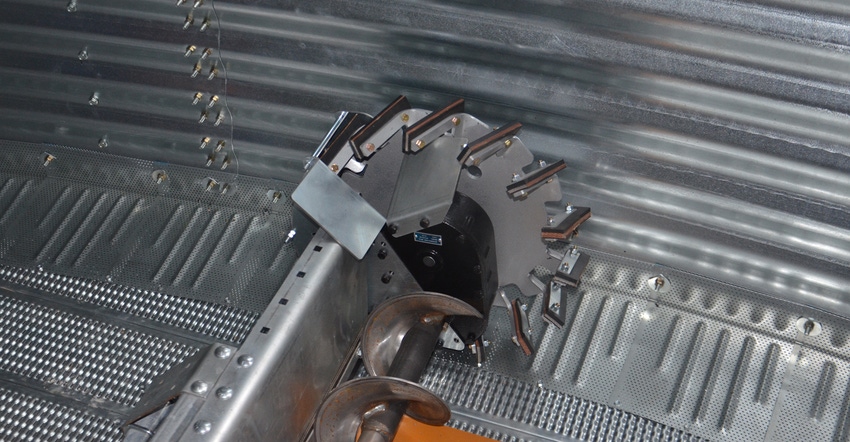October 14, 2021

Many of us remember the past and sometimes forget to update our knowledge. Using power sweeps in grain bins is an example. When the normal grain bin was a 27-foot or maybe a 30-foot-diameter bin with a 6-inch or 8-inch unload auger, the cost of a permanent power sweep was several times that of a light-duty, carry-in sweep, which you would bring in after most grain was unloaded. The economics and ease of moving a 13- to 14.5-foot, 4-inch sweep from bin to bin made good sense to many then.
Today, the average bin purchased in the U.S. is 48 feet or 54 feet in diameter. Instead of moving 10,000 bushels per year, we see bins with equipment moving 100,000 bushels or more. Six-inch unloading augers are rarely sold, with 10-inch augers being standard and U-troughs or under-bin drag conveyors not uncommon.
A carry-in sweep for larger-diameter bins can be 24 feet or longer, with a 6- or 8-inch sweep flight that must be broken down into two or three parts before moving. Almost always in larger bins today, you can purchase a power sweep for the same price as an unload auger and carry-in sweep. The economics may still work out if you have three or four of the same size bins, but even that is more unusual today. The sales of power sweeps have increased greatly for that reason.
Safety concerns
There is another, more important reason to buy a power sweep: safety. Early in my career, it surprised me how many farmers I visited who incurred an injury while moving a carry-in sweep. The use of power sweeps has reduced the incidence of injuries from never having to put a carry-in sweep in the bin, and often not having to enter at all to remove the grain down to the point of a final clean-up sweep with a broom.
Also, with bin diameters of 48 feet or larger, and sidewall heights now commonly at 50 to 75 feet, there is lots of grain in the bin and the potential for a vertical wall of out-of-condition grain to form. This creates an unsafe situation. If that vertical wall collapses with someone inside, entrapment is a very real concern.
I encourage producers to take a hard look at the difference in cost between a carry-in sweep and power sweep. And though not 100% effective, a power sweep is already in the bin, reducing labor needs, and it will get most, if not all, of that wall of grain down and removed from the bin with no one having to enter it.
Zero bin entry should be our goal. Just as we see more and more ladders, stairs and roof access handrails and platforms along with other safety equipment, we need to see more permanently installed sweeps that keep the farmer out of the bin.
As with all mechanical equipment, you should review and follow all manufacturer instructions on safety in installation, warning decal placement and sweep operation of power sweeps in bins.
Woodruff is a regional sales manager and grain storage specialist for GSI. Editor’s note: This story was requested to promote safety when handling grain and to encourage more people to stay out of bins. There are still areas where carry-in sweeps are used, requiring more entry into bins.
You May Also Like




